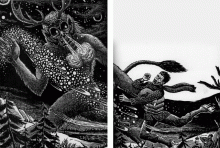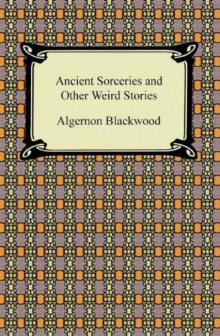- Home
- Algernon Blackwood
Ancient Sorceries And Other Weird Stories Page 2
Ancient Sorceries And Other Weird Stories Read online
Page 2
The Centaur, whose poignant and delicate evocation of the vitality of Nature makes it the centerpiece of Blackwood’s work, is the key to the understanding of both his oeuvre and his philosophy. What does the mysterious Russian (never named), whom O’Malley encounters on a steamer heading from Marseilles to the Caucasus Mountains, symbolize? He is a “Cosmic Being” (C 209), one so close to Nature that his very presence in this civilized company of tourists seems anamalous and even vaguely frightening. He leads O’Malley into the Caucasus—exactly as Blackwood himself went on a trip there in the summer of 1910—to what appears to be a herd of centaurs; more, not only the Russian but O’Malley himself seem, momentarily, to become centaurs. For O’Malley it is a moment of spiritual transformation: “The Garden now enclosed him. He had found the heart of Earth, his mother. Self-realization in the perfect union with Nature was fulfilled. He knew the Great At-one-ment” [C 214-15].
I have noted Blackwood’s trip to Egypt in early 1912. That trip was made in the company of Mabel (Maya) Stuart King (the Baroness de Knoop) and her husband, and it engendered not only the works already mentioned but also the curious novel The Wave (1916). This is far from being Blackwood’s most meritorious work, but its biographical significance may be considerable. It is dedicated, like several other volumes, to “M. S.-K.,” and one wonders what exact role Maya played in Blackwood’s life. Given that The Wave tells of an ancient Egyptian slave who loves a general’s wife, and given that Blackwood himself was a firm believer in reincarnation, the autobiographical implications of the novel become intriguing. Maya is at the center of several other works in which a nebulous, ill-defined longing for spiritual union with another human being is the focus. Possibly, for this lifelong bachelor, Maya—married and therefore unattainable—was the perfect object of adoration, although there is evidence that Maya returned Blackwood’s affection, at least in part. It appears difficult to deny that Blackwood, like Poe and Lovecraft, was largely asexual, sublimating any such tendencies into his work and his Nature-mysticism.
Blackwood spent much of the first two years following the outbreak of World War I in adapting his children’s fantasy A Prisoner in Fairyland (1913) into a musical, The Starlight Express, with music by Edward Elgar. Although he wrote a number of works for or about children, only Jimbo, The Education of Uncle Paul, and The Fruit Stoners (1934) are notably successful. It is clear that he himself was a genial “Uncle Paul” to a variety of nieces and nephews, as well as to the children of some of his friends. Children, like animals, had an instinctive psychological bond with Nature that rendered their world of imagination immediately comprehensible to Blackwood. Consider the nature metaphors used to describe the child Nixie in The Education of Uncle Paul:
... the name fitted her like a skin, for she was the true figure of a sprite, and looked as if she had just stepped out of the water and her hair had stolen the yellow of the sand. Her eyes ran about the room like sunshine from the surface of a stream, and her movements instantly made Paul think of water gliding over pebbles or ribbed sand with easy and gentle undulations. Flashlike he saw her in a clearing of his lonely woods, a creature of the elements.4
Blackwood was rarely able to reach this level of unsentimental pathos in his later works for children.
In a sense, the war marked the definite end of one stage—and, perhaps, the most vital and significant stage—of Blackwood’s career. The hostility to science and material civilization that Blackwood revealed through O’Malley (“And I loathe, loathe the spirit of to-day with its cheap-jack inventions, and smother of sham universal culture, its murderous superfluities and sordid vulgarity, without enough real sense of beauty left to see that a daisy is nearer heaven than an airship” [C 40]) was only augmented by the war, a product of the destructive forces that were taking all humanity farther and farther away from Nature. Julius LeVallon (1916), another novel of reincarnation, is confused and unfocused, and its sequel, The Bright Messenger (1921), is still more so, made interesting only by an increasing strain of pessimism: “The recent upheaval has been more than an intertribal war. It was a planetary event. It has shaken our nature fundamentally, radically. The human mind has been shocked, broken, dislocated.”5
In Blackwood’s short story writing, inspiration appears to have been drying up. The tales in Day and Night Stories (1917) are, on the whole, slight; The Wolves of God and Other Fey Stories (1921) consists of stories whose plots were in large part derived from Blackwood’s shared experiences with his old friend Wilfrid Wilson, who is listed as a coauthor; Tongues of Fire and Other Sketches (1924) is also disappointing. This was his last original collection of stories until Shocks (1935).
Blackwood, meanwhile, was devoting himself largely to the drama. Karma: A Re-incarnation Play, written with Violet Pearn, was published in 1918; it appears never to have been performed. Later plays—The Crossing (1920; with Bertram Forsyth), Through the Crack (1920; with Violet Pearn), White Magic (1921; with Bertram Forsyth), and Halfway House (1921; with Elaine Ainley)—were staged, although only The Crossing and Through the Crack were successful. Probably the most affecting of Blackwood’s works of the 1920s is his poignant account of the first three decades of his life, Episodes Before Thirty (1923). But travel—both abroad and to the homes of his many friends in England—made the 1920s a period of great contentment for Blackwood.
It was in the latter half of that decade that Blackwood returned to writing for children. A multifarious array of works were produced during this period, but none are particularly distinguished aside from Dudley and Gilderoy: A Nonsense (1929), a delightful fable about the adventures of a parrot and a cat as they stray out of their home, board a train, and perform other surprising antics. Several stories in Shocks, inspired by his absorption of the mystical philosophy of Georgi Gurdjieff and his disciple Pyotr Ouspenskii, show that Blackwood had not entirely finished having his say in the realm of supernatural horror, while other tales in that volume, notably “Elsewhere and Otherwise” and “The Man Who Lived Backwards,” both inspired by J. W. Dunne’s theories of serial time, could be almost classified as science fiction.
And yet, the 1930s brought about a change in Blackwood’s literary career that no one could have predicted: his transition from author to radio personality. His work for BBC Radio began in 1934, as he adapted his own previously published stories or created original tales for radio broadcasts. Still more remarkably, Blackwood appeared on a three-minute segment of Britain’s first commercial television broadcast on November 2, 1936, on the variety show Picture Page. Biographer Mike Ashley shows why Blackwood was “ideally suited for television”:
Now 67, his face was weather-beaten, tanned and immensely wrinkled, his head bald all bar a short fringe, the domed pate wrinkled and freckled. Through his visage shone two piercing, gripping, hypnotic eyes that were at the same time friendly, trusting and persuasive. Properly lit his face would seem to stand out in three dimensions from the screen.6
But he made no further appearances on television until after World War II.
In that war, of course, Blackwood was too old to serve in a military capacity, but that scarcely meant that he was exempt from its ravages. He came close to perishing when the home of his nephew at Lawn Road, Hampstead, where he was staying, suffered a direct hit from a German bomb on October 13, 1940. He survived by mere chance, but many of his papers and effects were destroyed. For Blackwood himself, scornful as he was of material possessions, this perhaps meant little, but it has meant much for our understanding of the course of Blackwood’s life: those papers could have filled in vital gaps in our knowledge of certain periods where we now have only tantalizing hints.
Blackwood continued writing for radio and television, but did relatively little original work in fiction. The fledgling American publisher Arkham House, wishing to lend prestige to its enterprise, persuaded him to assemble a slim collection of only two tales, The Doll and One Other (1946). It would be his last original story collection. In 1949 he was made a Command
er of the British Empire by King George VI; he remarked a trifle cynically in his diary, “Odd to be a Commander of an Empire which the bestowers of the honour have destroyed!”7 A month later he received the Television Society Medal for Outstanding Artistic Achievement. His work for radio and television continued almost up to the time of his death on December 10, 1951, at the age of eighty-two.
In The Centaur O’Malley, after his transcendent experience in the Caucasus, yearns to tell the world of what he has felt and learned—he thinks it will save humanity from sinking into an imag inationless morass of materialism and cynicism. His sympathetic but skeptical friend, Stahl, warns him: “You will reach no men of action; and few of intellect. You will merely stuff the dreamers who are already stuffed enough. What is the use, I ask you? What is the use?” (C 267-68). But O’Malley is determined to persevere.
And so was Blackwood. Perhaps in his later years he felt that the cause was lost; that science and material comforts had advanced so far that the awe and wonder of Nature were things of the past. In the essay “Dreams and Fairies” (1929) he nevertheless held out a faint hope that technology might not entirely crush our perception of the mysteries of the cosmos:
Ariel as a personified wave-length we listen to in our drawing-rooms, the “sightless couriers of the air” as waves of ether bringing us sound or pictures through a machine costing so many pounds—these, though wonderful, hold no wonder of the spirit. The wonder of the spirit is not the wonder of the well-read mind. The purchaser questions, but he does not tremble with delicious and unearthly awe.
To-day our winds seem thin of voices, our woods and forests emptying, our glens feed streams where dance no flashing feet. The haunting music of that older world is stilled and no wings dart across the moonlight that once was populated with haunting glory. It may be, however, that the glamour is but changing and that the poet’s creative heart will extract a more stimulating Wonder from the newer “facts” of life. Mystery, of course, there must always be. The change is worth underlining: it will be a Wonder that instructs; a Wonder that teaches before it beautifies.8
It is not entirely clear what is meant by that last remark; it could almost be seen as a justification for science fiction, a literary mode Blackwood never approached save in a few late works. Nevertheless, it is evident that he himself retained his sense of wonder to the end, and sought to convey it to others in as earnest and powerful a fashion as he could. Even if his best works were written in a relatively short period encompassed by the first two decades of the twentieth century, every one of his novels, tales, plays, and even essays and reviews seeks to uncover those layers of mystery that lurk behind the façade of the known—the mystery of forests, of deserts, of snow-capped peaks, and, most significant of all, of the human psyche. This is the final lesson that O’Malley learns:
“That the Garden’s everywhere! You needn’t go to the distant Caucasus to find it. It’s all about this old London town, and in these foggy streets and dingy pavements. It’s even in this cramped, un-dusted room. Now at this moment, while that lamp flickers and the thousands go to sleep. The gates of horn and ivory are here,” he tapped his breast. “And here the flowers, the long, clean open hills, the giant herd, the nymphs, the sunshine and the gods!” [C 273].
S. T. Joshi
SUGGESTIONS FOR FURTHER READING
PRIMARY
The best of Blackwood’s short story collections are his early volumes: The Empty House and Other Ghost Stories (1906), The Listener and Other Stories (1907), John Silence—Physician Extraordinary (1908), The Lost Valley and Other Stories (1910), Pan’s Garden: A Volume of Nature Stories (1912), and Incredible Adventures (1914). Collectively, these volumes constitute one of the most substantial bodies of short fiction in all weird literature. In these books will be found such memorable tales as “A Haunted Island,” “The Strange Adventures of a Private Secretary in New York,” “Max Hensig—Bacteriologist and Murderer,” “The Woman’s Ghost Story,” “Secret Worship,” “Old Clothes,” “The Temptation of the Clay,” “The Regeneration of Lord Ernie,” and “The Damned.” My edition of The Complete John Silence Stories (Dover, 1998) reprints the edition of 1908 with the addition of one later John Silence story.
Blackwood’s later story collections tend on the whole toward inconsistency and a decline in inspiration: Ten Minute Stories (1914), Day and Night Stories (1917), The Wolves of God and Other Fey Stories (1921; with Wilfrid Wilson), Tongues of Fire and Other Sketches (1924), Shocks (1935), and The Doll and One Other (1946). Each of these volumes, however, contains at least a few notable tales.
Late in his career, as Blackwood wrote fewer and fewer new tales, a variety of publishers began issuing reprint collections of his earlier work: Ancient Sorceries and Other Tales (1927), The Dance of Death and Other Tales (1927), Strange Stories (1929), The Willows and Other Queer Tales (1935), and (probably the best of the lot) The Tales of Algernon Blackwood (1938), which features a provocative author’s preface. Several other reprint collections appeared very late in Blackwood’s life or posthumously: Tales of the Uncanny and Supernatural (1949), In the Realm of Terror (1957), Selected Tales (1964), Tales of the Mysterious and the Macabre (1967), Ancient Sorceries and Other Stories (1968), and others. These volumes, although issued by such noted publishers as Pan theon, Dutton, and Penguin, do not always represent Blackwood to best advantage. The two best collections are E. F. Bleiler’s edition of Best Ghost Stories (Dover, 1973) and Mike Ashley’s edition of Tales of the Supernatural (Boydell Press, 1983), but both are out of print. A good many of Blackwood’s stories remain uncollected; Mike Ashley gathered some of the best of them in The Magic Mirror (Equation, 1989).
Blackwood did not write any actual “horror” novels, but a number of works can be said to mingle fantasy, awe, and wonder. Far and away the best of these is The Centaur (1911). The Human Chord (1910) powerfully explores the mystical properties of music. Julius LeVallon: An Episode (1916) and The Bright Messenger (1921), two interrelated novels broaching many of the themes in The Centaur, are intermittently intriguing but ultimately disappointing. The Wave: An Egyptian Aftermath (1916) is Blackwood’s most exhaustive treatment of the reincarnation theme, but it is marred by obscurity and sentimentality. The Garden of Survival (1918), inspired by the death of Blackwood’s brother, is a quietly moving short novel that also deals with reincarnation.
A number of Blackwood’s novels were written for, or about, children. The best of these are the first two, Jimbo (1909) and The Education of Uncle Paul (1909); the latter in particular, with its patently autobiographical protagonist, can stand as a pendant to The Centaur as Blackwood’s most heartfelt and engaging novel. Later novels—A Prisoner in Fairyland (1913), The Extra Day (1915), The Promise of Air (1918), Sambo and Snitch (1927), and The Fruit Stoners (1934)—are on the whole disappointing, although A Prisoner in Fairyland is nonetheless vital as an expression of Blackwood’s philosophy. Dudley and Gilderoy: A Nonsense (1929) is, however, a delightful fable.
Blackwood wrote numerous plays, but only two were published: Karma: A Re-incarnation Play (1918) and Through the Crack (1925), both cowritten with Violet Pearn.
Of Blackwood’s autobiography, Episodes Before Thirty (1923), with its winsome portrayal of the first three decades of his life, no praise can be excessive. His numerous essays and reviews, which include a number of fine travel sketches and several articles on theosophy, reincarnation, ghostly manifestations, and the art of writing, remain uncollected.
SECONDARY
The dearth of criticism on Algernon Blackwood is a literary crime of the first order. Only two book-length bibliographies have appeared to date: John Robert Colombo’s Blackwood’s Books (Hounslow Press, 1981), which was immediately superseded by Mike Ashley’s Algernon Blackwood: A Bio-bibliography (Greenwood Press, 1987); the latter remains the alpha and omega of Blackwood studies. Its detailed biographical introduction will whet the reader’s appetite for Ashley’s full-length biography, Starlight Man: The Extraordinary
Life of Algernon Blackwood (Constable, 2001), published in the U.S. as Algernon Blackwood: An Extraordinary Life (Carroll & Graf, 2001).
Two memoirs of Blackwood can be noted: Maude M. C. ffoulkes’s “Algernon Blackwood,” in her My Own Past (1915), and Arthur Compton-Rickett’s “Algernon Blackwood,” in his Portraits and Personalities (1937).
Stuart Gilbert’s “Algernon Blackwood: Novelist and Mystic” (Transition, July 1935), is the first substantial article on Blackwood and still retains its interest. But the first intelligent critical analysis is found in Peter Penzoldt’s chapter, “Algernon Blackwood,” in The Supernatural in Fiction (Peter Nevill, 1952); Penzoldt benefited from personal contact with Blackwood in the last years of the latter’s life. Derek Hudson’s “A Study of Algernon Blackwood” (Essays and Studies, 1961) is slight but contains some moving personal recollections. Jack Sullivan’s chapter “The Visionary Ghost Story: Algernon Blackwood,” in Elegant Nightmares: The English Ghost Story from Le Fanu to Blackwood (Ohio University Press, 1978), is marred by an incomplete reading of Blackwood’s work and a lack of sympathy with his modes of expression. Briefer discussions can be found in Julia Briggs’s Night Visitors: The Rise and Fall of the English Ghost Story (Faber & Faber, 1977) and David Punter’s The Literature of Terror (Longman, 1980). My own lengthy chapter, “Algernon Blackwood: The Expansion of Consciousness,” in The Weird Tale (University of Texas Press, 1990), discusses the whole of Blackwood’s work, although many tales and novels are necessarily dealt with cursorily. Mike Ashley has written several substantial articles: “Algernon Blackwood and the Golden Dawn” (Fantasy Commentator, winter 1984), “The Road to The Empty House” (Fantasy Commentator, fall 1985), “The Cosmic Connection” (Crypt of Cthulhu, St. John’s Eve, 1988), and “Lovecraft and Blackwood: A Surveillance” (Crypt of Cthulhu, Hallowmass, 1988). Jeffrey Goddin’s “Subtle Perceptions: The Fantasy Novels of Algernon Blackwood,” in Darrell Schweitzer’s Discovering Classic Fantasy Fiction (Borgo Press, 1996), is a somewhat sketchy examination of Blackwood’s novelistic output.

 Day and Night Stories
Day and Night Stories Four Weird Tales
Four Weird Tales The Wendigo
The Wendigo Three More John Silence Stories
Three More John Silence Stories The Garden of Survival
The Garden of Survival The Extra Day
The Extra Day The Bright Messenger
The Bright Messenger Collected Works of Algernon Blackwood
Collected Works of Algernon Blackwood The Empty House
The Empty House Three John Silence Stories
Three John Silence Stories 13 Tales of Terror
13 Tales of Terror A Prisoner in Fairyland
A Prisoner in Fairyland Ancient Sorceries And Other Weird Stories
Ancient Sorceries And Other Weird Stories The Algernon Blackwood Collection
The Algernon Blackwood Collection The First Algernon Blackwood Megapack: 36 Classic Tales of the Supernatural
The First Algernon Blackwood Megapack: 36 Classic Tales of the Supernatural John Silence, Physician Extraordinary
John Silence, Physician Extraordinary The Second Algernon Blackwood Megapack: 28 Classic Tales of the Supernatural
The Second Algernon Blackwood Megapack: 28 Classic Tales of the Supernatural The First Algernon Blackwood Megapack
The First Algernon Blackwood Megapack The Second Algernon Blackwood Megapack
The Second Algernon Blackwood Megapack